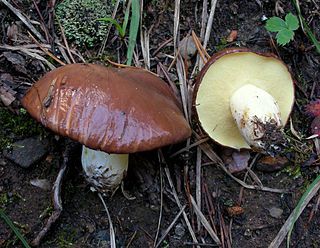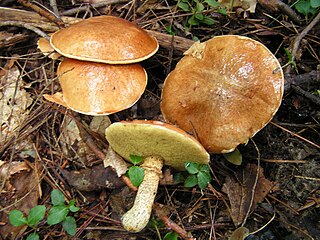
Suillus luteus is a bolete fungus, and the type species of the genus Suillus. A common fungus native all across Eurasia from Ireland to Korea, it has been introduced widely elsewhere, including North and South America, southern Africa, Australia and New Zealand. Commonly referred to as slippery jack or sticky bun in English-speaking countries, its names refer to the brown cap, which is characteristically slimy in wet conditions. The fungus, initially described as Boletus luteus by Carl Linnaeus in 1753, is now classified in a different fungus family as well as genus. Suillus luteus is edible, though not as highly regarded as other bolete mushrooms. It is commonly prepared and eaten in soups, stews or fried dishes. The slime coating, however, may cause indigestion if not removed before eating. It is often sold as a dried mushroom.

Alexander Hanchett Smith was an American mycologist known for his extensive contributions to the taxonomy and phylogeny of the higher fungi, especially the agarics.

Suillus brevipes is a species of fungus in the family Suillaceae. First described by American mycologists in the late 19th century, it is commonly known as the stubby-stalk or the short-stemmed slippery Jack. The fruit bodies (mushrooms) produced by the fungus are characterized by a chocolate to reddish-brown cap covered with a sticky layer of slime, and a short whitish stipe that has neither a partial veil nor prominent, colored glandular dots. The cap can reach a diameter of about 10 cm, while the stipe is up to 6 cm long and 2 cm thick. Like other bolete mushrooms, S. brevipes produces spores in a vertically arranged layer of spongy tubes with openings that form a layer of small yellowish pores on the underside of the cap.

Suillus lakei, commonly known as the matte Jack, Lake's bolete, or the western painted Suillus, is a species of fungus in the family Suillaceae. It is characterized by the distinctive reddish-brown tufted fibers or small scales on the cap, and the presence of a woolly veil on the stem. The caps can reach diameters of up to 15 cm, while the stems are between 6 and 12 cm long and usually 1–3 cm thick. On the underside of the cap is a layer of spongy yellow to yellow-brown angular pores; these pores are covered with a whitish partial veil when young. A mycorrhizal fungus, S. lakei grows in association with Douglas fir, and is found where this tree occurs. It is native to northwestern North America, but has been introduced to Europe, South America, and New Zealand. The mushroom is edible, but opinions vary considerably as to its quality.

Suillus spraguei is a species of fungus in the family Suillaceae. It is known by a variety of common names, including the painted slipperycap, the painted suillus or the red and yellow suillus. Suillus spraguei has had a complex taxonomical history, and is also frequently referred to as Suillus pictus in the literature. The readily identifiable fruit bodies have caps that are dark red when fresh, dry to the touch, and covered with mats of hairs and scales that are separated by yellow cracks. On the underside of the cap are small, yellow, angular pores that become brownish as the mushroom ages. The stalk bears a grayish cottony ring, and is typically covered with soft hairs or scales.

Suillus pungens, commonly known as the pungent slippery jack or the pungent suillus, is a species of fungus in the genus Suillus. The fruit bodies of the fungus have slimy convex caps up to 14 cm (5.5 in) wide. The mushroom is characterized by the very distinct color changes that occur in the cap throughout development. Typically, the young cap is whitish, later becoming grayish-olive to reddish-brown or a mottled combination of these colors. The mushroom has a dotted stem (stipe) up to 7 cm (2.8 in) long, and 2 cm (0.8 in) thick. On the underside on the cap is the spore-bearing tissue consisting of minute vertically arranged tubes that appear as a surface of angular, yellowish pores. The presence of milky droplets on the pore surface of young individuals, especially in humid environments, is a characteristic feature of this species. S. pungens can usually be distinguished from other similar Suillus species by differences in distribution, odor and taste. The mushroom is considered edible, but not highly regarded.

Suillus glandulosipes is a species of edible mushroom in the genus Suillus. It was first described scientifically by American mycologists Harry D. Thiers and Alexander H. Smith in 1964.

Suillus intermedius is an edible species of mushroom in the genus Suillus. It is found in North America, Costa Blanca Mountains-Spain.
Suillus subalutaceus is an edible species of mushroom in the genus Suillus. It is found in North America and in Taiwan.

Suillus cavipes, commonly known as the hollow foot is an edible species of mushroom in the genus Suillus. It is found in Europe and North America. It is associated with larch in the Pacific Northwest.

Suillus fuscotomentosus, commonly known as the poor man's slippery jack, is an edible species of mushroom in the genus Suillus. Found in western North America, it was described as new to science in 1964 by mycologists Harry Delbert Thiers and Alexander H. Smith. It usually grows under three-needle pines, such as ponderosa pine and Monterey pine. Although it is edible, it is often considered to be of poor quality.
Suillus flavogranulatus is a bolete mushroom in the genus Suillus native to North America. It was described as new to science in 1965 by mycologists Alexander H. Smith, Harry Delbert Thiers, and Orson K. Miller.
Suillus pallidiceps is a species of bolete fungus in the family Suillaceae. It was first described scientifically by American mycologists Alexander H. Smith and Harry D. Thiers in 1964.

Suillus ponderosus is a species of bolete fungus in the family Suillaceae. It was first described scientifically by American mycologists Alexander H. Smith and Harry D. Thiers in 1964.
Suillus acerbus is a species of bolete fungus in the family Suillaceae. It was first described scientifically by American mycologists Alexander H. Smith and Harry D. Thiers in 1964.
Suillus appendiculatus is a species of bolete fungus in the family Suillaceae. It was first described scientifically in 1896 as a species of Boletinus by American mycologist Charles Horton Peck. Harry D. Thiers and Alexander H. Smith transferred it to the genus Suillus in 1964.

Suillus brunnescens is a species of bolete fungus in the family Suillaceae. It was first described scientifically by American mycologists Alexander H. Smith and Harry D. Thiers in 1964.

Suillus caerulescens, commonly known as the douglas-fir suillus is an edible species of bolete fungus in the family Suillaceae. It was first described scientifically by American mycologists Alexander H. Smith and Harry D. Thiers in 1964. It can be found growing with Douglas fir trees. Its stem bruises blue, which sometimes takes a few minutes.
Suillus borealis is a species of bolete fungus in the family Suillaceae. Found in western North America where it associates with western white pine, the fungus was described as new to science in 1965 by mycologists Alexander H. Smith, Harry Delbert Thiers, and Orson K. Miller. It is similar in appearance to Suillus luteus, but unlike in that species, the partial veil does not form a ring on the stipe.

Suillus kaibabensis is a species of fungus in the family Boletaceae. The species was first described scientifically by American mycologist Harry D. Thiers.














